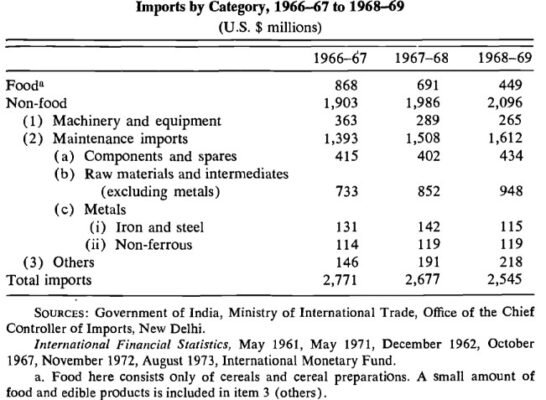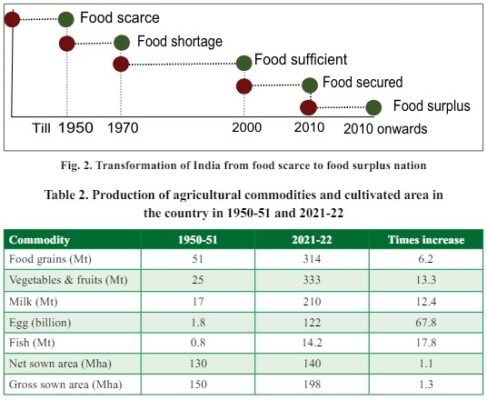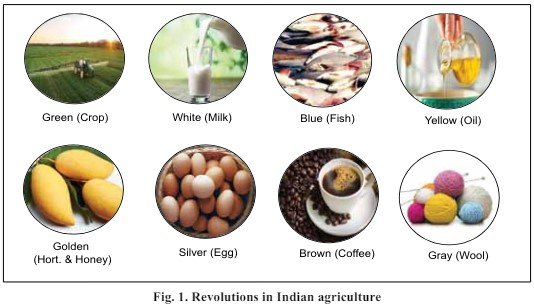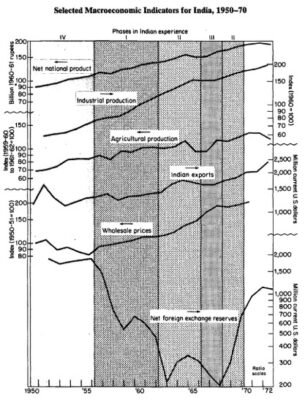


India’s remarkable transformation from a net food importer to a net food exporter can be attributed to several key factors:
- Green Revolution (1960s and 1970s):
-
- High-yielding varieties of seeds, especially for wheat and rice, were introduced.
- Modern farming techniques, fertilizers, and improved irrigation significantly boosted agricultural productivity.
- Improved Irrigation:
-
- Projects like the Bhakra-Nangal Dam and canal networks ensured consistent water supply, reducing dependence on monsoons.
- Agricultural Policies:
-
- Minimum Support Prices (MSP) guaranteed income for farmers, encouraging higher production.
- Supportive policies incentivized agricultural growth.
- Infrastructure Development:
-
- Investments in rural infrastructure, including roads and storage facilities, facilitated efficient movement and storage of produce.
- Agricultural Research and Education:
-
- Institutions like the Indian Council of Agricultural Research (ICAR) led research, developing better crop varieties and farming techniques.
- Diversification into High-Value Crops:
-
- Indian farmers diversified into horticulture, aquaculture, and floriculture, enhancing export potential.
- Initiatives like Operation Flood:
-
- Launched in the 1970s, it transformed India into the world’s largest milk producer.
- Market Reforms (Post-1990s):
-
- Efforts to reduce middlemen’s role improved prices and supply chains for farmers.
- Global Market Demand:
-
- Increased demand for food products globally, especially in the Middle East and Africa, opened new export markets.
- Government Schemes:
-
- Initiatives like Pradhan Mantri Krishi Sinchayee Yojana (PMKSY) and e-NAM strengthened the agricultural sector.
In conclusion, a combination of technological advancements, policy decisions, and market-oriented strategies propelled India’s transition from a net food importer to a successful exporter, showcasing the potential of coordinated efforts in achieving food security and economic success.
…………………………………………………………..
Must read:
Self-reliant agriculture is critical for the goal of an Atmanirbhar Bharat. For this, agricultural export is extremely important as besides earning precious foreign exchange for the country, the exports help farmers/producers/exporters to take advantage of wider international market and increase their income. Exports have also resulted in increased production in agriculture sector by increasing area coverage and productivity.
As per WTO’s Trade Statistics, share of India’s agricultural exports and imports in the world agriculture trade in 2017 was 2.27% and 1.90%, respectively. Even during the difficult time of pandemic lockdown, India took care to not to disturb the world food supply chain and continued to export. The exports of Agri commodities during March 2020 to June 2020 were Rs. 25552.7 Crore against an export of Rs. 20734.8 Crore during the same period in 2019, showing a sharp increase of 23.24%.
The agricultural exports as a percentage of India’s agricultural GDP has increased from 9.4 % in 2017-18 to 9.9 % in 2018-19. While the agricultural imports as a percentage of India’s agricultural GDP has declined from 5.7 % to 4.9 % indicating exportable surplus and decreased dependence on import of agricultural products in India.
Giant strides have been made in agri export since independence. In 1950-51, India’s agri export was about Rs. 149 crores which has risen to the level of Rs. 2.53 lakh crores in 2019-20. There has been substantial increase in export of almost all the agricultural items in the last 15 years, but despite being one of the top producers of agricultural products, India does not figure among top exporters of agricultural produce. For example, India holds second rank in the world wheat production but ranks 34th in export. Similarly, despite being world No. 3 in production of vegetables, the export ranking of India is only 14th. Same is the case for fruits, where India is the second largest producer in the world but export ranking is 23rd. To reach the ranks of top exporting nation in Agriculture, commensurate with the production, there is a clear and categorical need to take proactive interventions.
In view thereof, DAC&FW has prepared a comprehensive action plan/strategy towards promotion of agri trade. A detailed exploration of data and issues of pre-production, production, and post-harvest has been undertaken to evolve an end to end approach for developing a holistic strategy. An analysis of product groups and then specific commodities has been done with regard to present status of production & exports, strengths, challenges and thereafter interventions have been identified after consultations with stakeholders. The twofold approach addresses boosting Agri Export with emphasis on value addition and focused action plan for Import Substitution. The interventions so identified have been converted into a timed action plan.
To mention a few, the Export strategy focuses on export promotion of fast evolving niche markets of Wellness food/ Health conscious food/nutraceuticals; Development of “Brand India” in campaign mode to help penetration into new foreign markets and of new products which automatically translates into higher value realization; Gulf countries have been identified as focus destination to increase the market share which is a strong market for India though presently India caters to only 10-12% share of their total imports. A product market matrix has been made containing list of products of strength which could be expanded in new geographies and list of known markets which can be introduced with newer products.
It is also noted that Horticulture is a growing sub-sector. India holds 2nd position in production of fruits and vegetables. It exports 8.23 Lakh MT (LMT) of fruits worth Rs 5,638 crore and 31.92 LMT of vegetables worth Rs. 5,679 Crores annually. Grapes occupy the premier position in fresh fruit exports followed by Mango, Pomegranate, Banana, and Oranges. In fresh vegetable export basket, Onions, Mixed Vegetables, Potatoes, Tomatoes, and Green Chilly are the major items. However, world trade of fruits and vegetables is US$ 208 billion and India’s share is miniscule. There is huge potential to increase export in fruits and vegetables. As such, specific strategy for export promotion has also been evolved for Fresh Fruits & Vegetables with specific emphasis on grapes, mango, pomegranate, onion, potato & Cucumber-Gherkin.
It is also emphasized that the existing Agri clusters are required to be strengthened and more product clusters to be developed to fulfil the gap of bulk quantity and quality of supplies. A time bound action plan has also been prepared for import substitution with particular focus upon Edible Oils, Cashew, fruits and spices thereby making India self –reliant.
At the behest of Department of Agricultural Cooperation & Farmers’ Welfare, Ministry of Agriculture, product specific Export Promotion Forums have been created to lead agri exports to new heights. Export promotion forums (EPFs) for eight agri & allied products viz. Grapes, Mango, Banana, Onion, Rice, Nutri-Cereals, Pomegranate and Floriculture have been constituted under the aegis of Agricultural and Processed Food Products Export Development Authority (APEDA), Department of Commerce.
Each Export Promotion Forum shall be having exporters of the related commodity as its members along with official members representing concerned Ministries/Departments of the Central and State Governments. Chairman APEDA shall be the chairman of each of these forums. The forums will meet at least once in every two months, to discuss/ make recommendations on issues pertaining to export of the respective commodity and invite experts etc. to the meeting for interaction, as required.
The Forums will constantly monitor and identify/anticipate developments in the external/internal situation pertaining to the production and export of their respective commodity and recommend /intervene for taking the necessary policy/ administrative measures. They will be in active touch with the producers, exporters and other relevant stakeholders of respective commodities and hear their problems, and facilitate, support and provide solutions to them. They will regularly study the market for respective commodities on a global basis, and identifying opportunities and developments / implications for domestic entities, and disseminate the same expeditiously to domestic producers and exporters.
The recommendations of the forum will be placed in the product committee / Authority of APEDA. The Forum will keep in close contact with the concerned organization of Ministry of Agriculture such as MIDH, Extension, NPPO etc., DGFT, Ministry of Civil Aviation, MoFPI etc. to further the interest of agricultural export. [Source: PIB]



